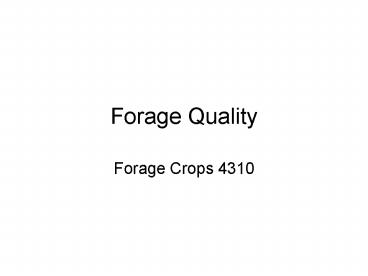Forage Quality - PowerPoint PPT Presentation
1 / 31
Title:
Forage Quality
Description:
Dung pats. Urine patches. Sugar content. Etc. How much weight should palatability carry? ... Cattle are able to use low-quality forages to produce a high ... – PowerPoint PPT presentation
Number of Views:209
Avg rating:3.0/5.0
Title: Forage Quality
1
Forage Quality
- Forage Crops 4310
2
Many ways to assess forage quality
- Human eye
- Laboratory
- Animal acceptance and performance
3
Palatability
- In general, animals select the best plant
- But, not always true
4
Palatability is affected by
- Texture
- Aroma
- Succulence
- Leafiness
- Fertilization
- Dung pats
- Urine patches
- Sugar content
- Etc.
5
How much weight should palatability carry?
- Probably not much!
- Fescue not particularly palatable, but is the
backbone of our grazing economy
6
Ruminant Digestion
- Cattle are able to use low-quality forages to
produce a high-quality source of vitamins,
minerals, energy protein in the form of meat
milk - This is because they are ruminants
- Microbes in their digestive system ferment
cellulose which non-ruminants (humans, pigs) do
not have
7
Ruminant Digestion
- Main source of energy
- Humans - glucose
- Cattle - volatile fatty acids (VFA)
- The compartments of the ruminant digestive system
are - Rumen
- Reticulum
- Omasum
- Abomasum
8
Ruminant Digestive Tract
9
Horse digestive tract
10
Comparative Capacity of the GI Tractof Different
Species
11
FORAGE PREFERENCE BY HERBIVORES
12
HOURS SPENT GRAZING / BROWSING PER DAY
C Cattle S Sheep G Goats H Horses
13
Forage Composition
- Plants, as fed, in pasture are 70 90 water.
Silage is typically 55 65 water. Hay is
around 10 15 water. But we often express
forage analysis on a dry matter basis - All requirement tables (next chapter) are
presented on dry matter basis - Converting to dry matter basis allows more
accurate comparison of feedstuffs
14
Converting to dry matter basis
- Divide by dry matter (DM) percentage
- Example problem Hay is 9 crude protein (cp) on
as fed basis and corn silage is 4 cp on same
basis. Hay is 90 DM and silage is 35 DM.
Which is really higher in cp (on dry matter
basis)?
15
Converting to dry matter basis
- Nutrient on DM Basis Nutrient on AF
Basis x 100 - DM
- Hay CP on DM Basis (9 90) x 100
10 - Silage CP on DM Basis (4 35) x 100 11.4
16
Two basic forage constituents
- Cell contents (non-structural) protein, sugar
and starch highly digestible - Structural cellulose, hemi-cellulose and lignin
vary in digestibility
17
Protein
- Presented as Crude Protein N x 6.25
- Plant cell walls contain up to 40 of the
protein, much of which is not available to the
animal - Other factors affecting protein availability
crop species, stage of maturity at harvest
18
Protein
- Basics
- The major component of muscle, hair, hooves,
skin, internal organs and body chemicals - Composed of smaller units, Amino Acids
- Beef rations balanced for protein rather than
individual amino acids - Rumen microbes digest most of protein and change
it to microbial protein
19
Protein
- (continued)
- Referred as Crude Protein (CP) - a reliable
estimate of the protein content - Another method of expressing protein
- Metabolizable Protein (MP) system
- Degradable Intake Protein (DIP)
- Undegradable Intake Protein (UIP)
- The MP system takes into account how protein is
used by both the animal and the microbes in the
rumen
20
Energy
- Basics
- Nutrient that is provided in largest quantity and
is fuel for the body usually most limiting in
forages - Total Digestible Nutrients (TDN) is most often
used as an energy measure - Additional terms to describe efficiency
- Digestible Energy (DE)
- Metabolizable Energy (ME)
- Net Energy (NE)
21
More on Energy
- Non-structural carbohydrates in forages are
readily digested - Ruminants and horses have ability to digest
cellulose and hemicellulose, but not lignin. As
lignin increase, digestibility decreases. - White clover, birdsfoot trefoil, small grains are
low in lignin - Alfalfa increases in lignin with age
- Bermudagrass lignifies fairly quickly
22
Factors affecting plant quality
- Plant species
- Plant part
- Climate
- Stage of maturity
- Fertilization
- Diurnal Fluctuations
- Other (rain on hay, poor hay storage)
23
Plant SpeciesWhich is more digestible
- Cool season grasses gt Warm season
- Cool season annuals gt Cool season perennial
- Legumes gt grasses
- Dallisgrass gt Bermudagrass
24
Quality Comparisons plant parts
- Leaves gt Stems
- Young leaves gt Old leaves
- Healthy plants gt Diseased plants
25
Climate
- Spring plants gt summer plants
- High Temperature increase lignification, so
decreases quality - Tannin also increases with hot weather in Sericea
26
Stage of maturity
- In general, as plants mature, quality declines
(see following slide) - Exception White clover holds quality due to lack
of true stems
27
Plant growth rate at various stages of growth
28
Tall fescue protein content as plants mature
seedhead production
May
June
July
Bates. 2000. Unpublished data. Plateau Experiment
Station.
29
Diurnal fluctuations
- Soluble Carbohydrate levels vary high in late
afternoon, low in early morning - Hay cut in late afternoon will be higher in
soluble carbs. - Cattle do 60 of grazing in late afternoon
early night
30
Methods of measuring forage quality
- Visual
- Neutral Detergent Fiber and Acid Detergent Fiber
- In-vitro fermentation
- Near infrared reflectance spectroscopy (NIRS)
31
Relative Feed Value
- A percentage figure that compares hay to Alfalfa
harvested at full bloom at 100 - Variables include DDM from ADF and DMI from NDF
- Good predictor of animal performance because it
considers both energy and intake
32
Visual Evaluation
- Stage of Harvest
- Leafiness
- Color
- Odor
- Softness
- Penalties































